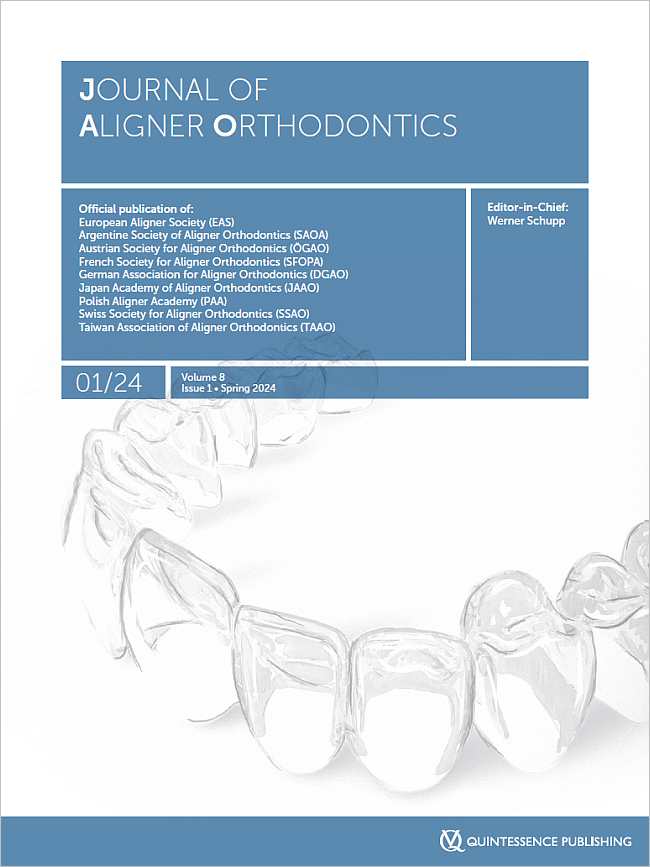Journal of Aligner Orthodontics, 4/2023
Original Scientific ArticleSeiten: 285-294, Sprache: EnglischTraversa, Flavio / Mah, James
Objective: The present study focused on the biomechanical dynamics of clear aligners in managing translational movement with a view to exploring the effects of trimline design and buccopalatal translation on the force and moments acting on the maxillary right central incisor in vitro.
Materials and methods: The Orthodontic Force Simulator (Institut Straumann, Basel, Switzerland), a device proficient at evaluating the biomechanical performance of aligners, was used to examine buccopalatal translations of the maxillary right central incisor. The present authors used a human head model to prepare a model of the maxilla with independent teeth, which was then segmented and interfaced with the Orthodontic Force Simulator. Thirty aligners were crafted from ClearQuartz material (ClearCorrect, Round Rock, TX, USA) in a process that encompassed intraoral scanning, digital superimposition, 3D printing, thermoforming and laser trimming. The central incisor’s forces and moments were assessed across four scenarios combining flat/scalloped trimlines and buccal/palatal translation.
Results: The highest translational force (7.51 N) and tipping moment (15.94 Ncm) were recorded for palatal translation coupled with a flat trimline. This was followed in descending order by buccal translation with a flat trimline (5.49 N and 12.46 Ncm), palatal translation with a scalloped trimline (4.93 N and 10.64 Ncm), and buccal translation with a scalloped trimline (2.96 N and 6.58 Ncm). Each tested scenario generated a clinically relevant translational force; however, the presence of undesirable buccopalatal tipping moments indicated potential off-target movements in an in vivo context.
Conclusion: The present findings highlight the substantial influence of the aligner trimline design and direction of translation on force and moment generation. Flat trimlines and palatal translation were associated with higher forces and moments compared to scalloped designs and buccal translation, respectively. These findings underscore the importance of careful aligner design in achieving the desired orthodontic outcomes; however, further research is required to gain a comprehensive understanding of aligner–tooth interactions and their implications for clear aligner therapy.
Schlagwörter: aligner biomechanics, bodily movement, flat trimline, orthodontic force simulator, scalloped trimline
Journal of Aligner Orthodontics, 1/2023
Review articleSeiten: 7-12, Sprache: EnglischMah, James / Higson, Maron
A relatively new complication of aligner therapy is emerging in the literature. Many clinicians have witnessed unplanned tooth movements during aligner treatment and, for the most part, have not found an explanation for this. A common site of this occurrence appears to be the maxillary lateral incisors in cases where these teeth are relatively intruded. This has been described in the literature as the “watermelon seed” effect. Since then, other data have emerged regarding the biomechanics within aligners that may be responsible for it. Accordingly, this review aims to evaluate the available evidence regarding this complication of aligner therapy and consider strategies to minimise or eliminate it.
Schlagwörter: biomechanics, complication, materials, plastics, tooth movements, unplanned
Journal of Aligner Orthodontics, 3/2022
Review articleSeiten: 153-162, Sprache: EnglischKrey, Karl-Friedrich / Abu-Tarif, Asad / Haubrich, Julia / Elkholy, Fayez / Mah, James / Schupp, Werner
Artificial intelligence is now involved in many aspects of our everyday life. In digital orthodontic practice in particular, practitioners are constantly and mostly unknowingly confronted with different levels of implementations of artificial intelligence. The present article, the third in a three-part series, will seek to shed light on some of these algorithms using common examples from a standard orthodontic digital workflow.
Schlagwörter: aligner orthodontics, artificial intelligence, digital orthodontics, machine learning
Journal of Aligner Orthodontics, 2/2022
Review articleSeiten: 85-92, Sprache: EnglischElkholy, Fayez / Abu-Tarif, Asad / Schupp, Werner / Haubrich, Julia / Mah, James / Krey, Karl-Friedrich
Artificial intelligence is now involved in many aspects of our daily life. In digital orthodontic practice in particular, practitioners are constantly and mostly unknowingly confronted with different levels of implementations of artificial intelligence. The present article, the second in a three-part series, will seek to shed light on some of these algorithms using common examples from a standard orthodontic digital workflow.
Schlagwörter: aligner orthodontics, artificial intelligence, digital orthodontics, machine learning
Journal of Aligner Orthodontics, 4/2021
Review articleSeiten: 251-258, Sprache: EnglischSchupp, Werner / Abu-Tarif, Asad / Haubrich, Julia / Elkholy, Fayez / Mah, James / Krey, Karl-Friedrich
Artificial intelligence is now firmly established in society. Whether we are searching on Google (Mountain View, CA, USA), being guided by recommendation algorithms or using facial recognition or smart home software, artificial intelligence is a daily presence in our lives, and in almost all areas: business, science, medicine, and increasingly in orthodontics. What is artificial intelligence, what does it encompass, what can it already do in orthodontics and where is it taking us in the discipline? What opportunities does it offer and what negative effects does it have? In this article, the first in a three-part series, we will discuss these questions and strive to answer them.
Schlagwörter: aligner orthodontics, artificial intelligence, convolutional neural networks, deep learning, machine learning, neural networks
Journal of Aligner Orthodontics, 3/2021
Open AccessOriginal Scientific ArticleSeiten: 175-183, Sprache: EnglischSchmidt Dolci, Gabriel / Ferguson, Donald / Vaid, Nikhilesh R. / Mah, James / Cardon, Stefan
Early interception of anterior crossbite has functional, structural and aesthetic benefits that have been widely enumerated in the literature. The goal of early interception usually involves proclination of the maxillary incisors, thus eliminating mandibular anterior shift; maxillary disjunction and protraction to correct transverse and sagittal deficiencies, respectively; and maintenance or improvement of mandibular compensation, thus creating as much horizontal overlap as possible. The present study illustrates a case treated for 24 months with a modified Catalan appliance incorporated into in-office aligners. The treatment results highlighted the efficacy of hybrid mechanics for mandibular compensation and protraction of the maxillary dentition. The 5-year follow-up demonstrated relative stability of the final outcome.
Schlagwörter: anterior crossbite, Class III treatment, clear aligners, extraoral traction appliance, growing patient, in-office aligners, interceptive orthodontics, maxillary arch expansion, removable orthodontic appliances
Journal of Aligner Orthodontics, 1/2021
Original Scientific ArticleSeiten: 23-32, Sprache: EnglischMah, James / Lee, Andrew
Journal of Aligner Orthodontics, 2/2020
EditorialSeiten: 87-90, Sprache: EnglischMah, James
Journal of Aligner Orthodontics, 2/2019
Case reportSeiten: 107-118, Sprache: EnglischMah, James K.
Patients with the characteristics of hyperdivergent facial patterns (dolichocephaly, shallow overbite and anterior open bites) are generally considered to be challenging to treat as many biomechanical approaches have extrusive side-effects that may lead to further bite opening and exasperate the clinical issues. However, with the increasing numbers of patients undergoing clear aligner therapy, there is a general clinical consensus that clear aligners are a good treatment option for this group of patients as vertical facial dimensions are not significantly affected with treatment. In the absence of literature on this topic, clinical cases are presented to demonstrate successful treatment of dolichocephalic patients with the ClearCorrect clear aligner system. These cases support the general notion that patients with increased facial dimensions can be treated with clear aligner therapy without adverse vertical changes.
Schlagwörter: aligner, facial dimension, hyperdivergent, open bite, orthodontic, vertical
International Journal of Computerized Dentistry, 4/2017
PubMed-ID: 29292411Seiten: 363-375, Sprache: Englisch, DeutschRobben, Jan / Muallah, Jonas / Wesemann, Christian / Nowak, Roxana / Mah, James / Pospiech, Peter / Bumann, Axel
Plaster casts can be digitized with desktop scanners, intraoral scanners, and recently also with cone beam computed tomography (CBCT). The aim of this study was to investigate the accuracy of five different CBCT devices digitizing a plaster cast. A study cast serving as a patient was made using the double mix impression technique, and the impression was poured out with plaster. On the resulting plaster cast, arch length (AL), intermolar width (IMW), and intercanine width (ICW) were measured by a coordinate measuring machine (CMM) (Zeiss O-Inspect 422). The patient cast was then scanned by five CBCT devices - CS 9300, CS 9300 Select, CS 8100 3D (all Carestream), Promax 3D Mid (Planmeca), and Whitefox (Acteon) - in eight scan modes. For each CBCT device, 37 scans were performed. The resulting DICOM data were exported as stereolithographic (STL) data and linearly measured using Convince Premium 2012 (3Shape) software. All measurements were compared to the reference master values of the patient cast. The accuracy measurements showed significant differences among the CBCT devices. The highest accuracy was achieved by Whitefox (IMW: mean ± standard deviation (SD): 5.5 ± 5.7 µm) and CS 9300 (IMW: -15 ± 7.4 µm). Comparable results with less accuracy were shown by CS 8100 3D (IMW: -81.2 ± 7.4 µm) and CS 300 Select (IMW: -82.2 ± 6.6 µm). Significantly lower accuracy was shown by Promax 3D Mid (IMW: -126.1 ± 4.8 µm). Some CBCT devices are suitable for the digitization of plaster casts and show very good clinical accuracy. Dental offices equipped with CBCT devices could digitize plaster casts without the need for additional devices.
Schlagwörter: CBCT devices, accuracy, indirect digitization, plaster cast, CAD/CAM, stereolithography




